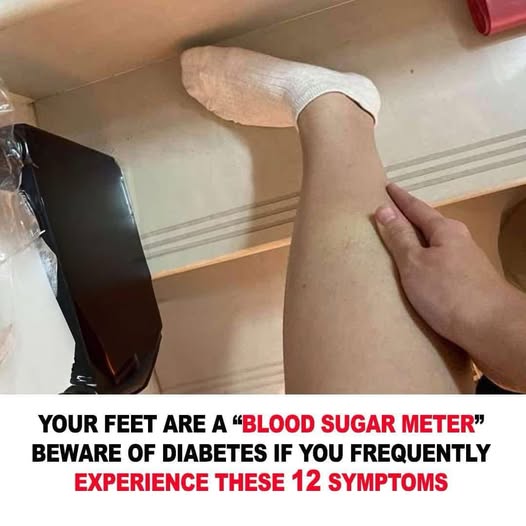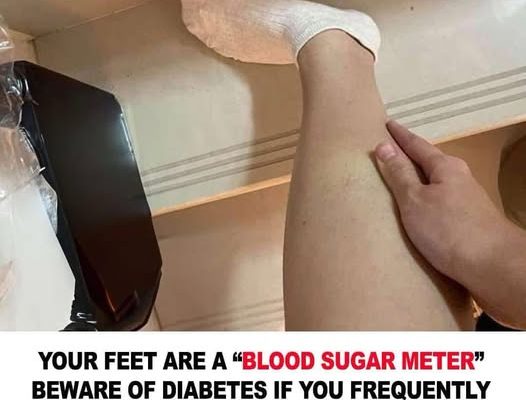Your Feet Are a “Blood Sugar Meter”: 12 Silent Signs of Diabetes You Shouldn’t Ignore
When we think of diabetes symptoms, we often focus on thirst, hunger, or fatigue. But the feet are often the first place to reveal the impact of elevated blood sugar levels. That’s because diabetes affects both the nervous system (causing diabetic neuropathy) and the circulatory system (causing poor blood flow), which are essential for healthy feet.
Ignoring these signs may lead to serious complications—including ulcers, infections, and even amputation. If you experience any of the following symptoms frequently, it could be your body’s way of warning you about undiagnosed or uncontrolled diabetes.

🦶 1. Tingling or Numbness in the Feet and Toes
This is one of the earliest and most common signs of diabetic neuropathy. As nerves get damaged by excess glucose, you may feel:
- Pins-and-needles sensation
- Numbness that comes and goes
- A sense of “walking on cotton” or having reduced foot sensitivity
❄️ 2. Cold Feet (Even in Warm Temperatures)
Poor circulation caused by narrowed blood vessels can make your feet feel unusually cold. If your feet remain cold while the rest of your body is warm, it could be a sign of compromised peripheral blood flow, commonly seen in diabetes.
🔥 3. Burning or Shooting Pain
A burning sensation in your feet—especially during the night—can indicate nerve damage from high blood sugar. This may progress to sharp or stabbing pain in advanced stages.
💥 4. Frequent Foot Cramps
Muscle cramps in the feet or legs, especially at night, may result from electrolyte imbalances and circulation issues due to diabetes. This may worsen if diabetes is poorly managed.
🩹 5. Slow-Healing Cuts, Blisters, or Sores
Diabetes reduces the body’s ability to fight infection and repair damaged tissue. A simple blister can quickly become a chronic wound or ulcer if left untreated. This is a major concern that can lead to serious infections or amputations.
🧴 6. Dry, Cracked Skin (Especially on Heels)
Neuropathy can reduce your ability to sweat, leading to dry, flaky skin. Cracks in the heels create entry points for bacteria, increasing the risk of foot infections.
💧 7. Swelling in the Feet and Ankles
Persistent swelling can indicate fluid retention, which may be caused by:
- Poor blood circulation
- Kidney dysfunction (another diabetes complication)
- Venous insufficiency
🧫 8. Frequent Fungal or Bacterial Infections
Diabetics often struggle with weakened immunity. You may notice:
- Athlete’s foot (itchy, flaky skin)
- Toenail fungus (thickened or yellow nails)
- Infections that recur or worsen quickly
🎨 9. Discoloration or Dark Patches
- Bluish or purplish skin may indicate poor oxygen supply.
- Red patches can be a sign of inflammation or infection.
- Blackened skin (necrosis) in severe cases is a medical emergency, often due to gangrene.
🧬 10. Hair Loss on Feet or Toes
Hair growth on your toes or feet may slow or stop entirely due to reduced blood flow. This is a classic sign of peripheral arterial disease (PAD), commonly found in diabetic patients.
🦠 11. Thick, Brittle, or Discolored Toenails
Changes in toenail health may result from:
- Fungal infections
- Nutritional deficiencies
- Poor circulation Diabetics may notice thickened nails, yellowing, or nails that are hard to trim and grow abnormally.
🚶 12. Pain While Walking That Eases at Rest (Claudication)
This symptom, known as intermittent claudication, occurs when blood flow to the muscles is limited during activity. If you feel pain in your feet or calves while walking but it goes away when you stop, it may point to vascular disease, a major diabetic complication.
✅ What to Do If You Notice These Symptoms
If you are experiencing any of the signs above—especially more than one—don’t ignore them. Here’s what you should do:
- ✅ Schedule a blood glucose test to check for diabetes or prediabetes.
- ✅ Inspect your feet daily, especially if you already have diabetes.
- ✅ Keep blood sugar levels under control through diet, exercise, and medication if prescribed.
- ✅ Consult a podiatrist or doctor for proper foot care and preventive treatment.
Your feet might not speak, but they can tell you a lot about your health. Treat them like your body’s natural blood sugar alert system. Being aware of these symptoms can help catch diabetes early—and prevent irreversible damage.



